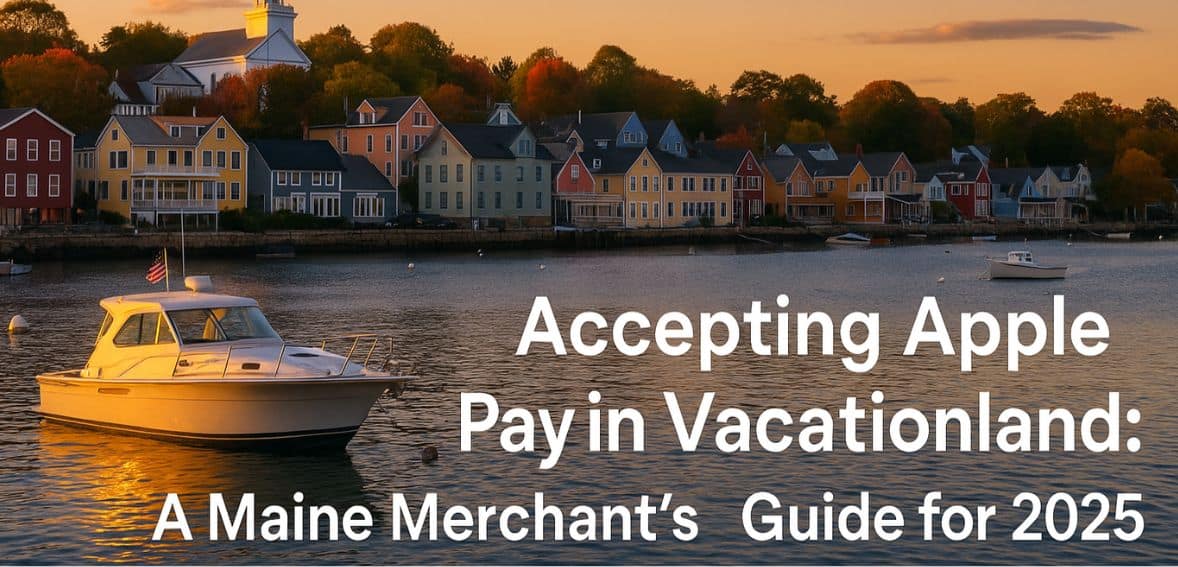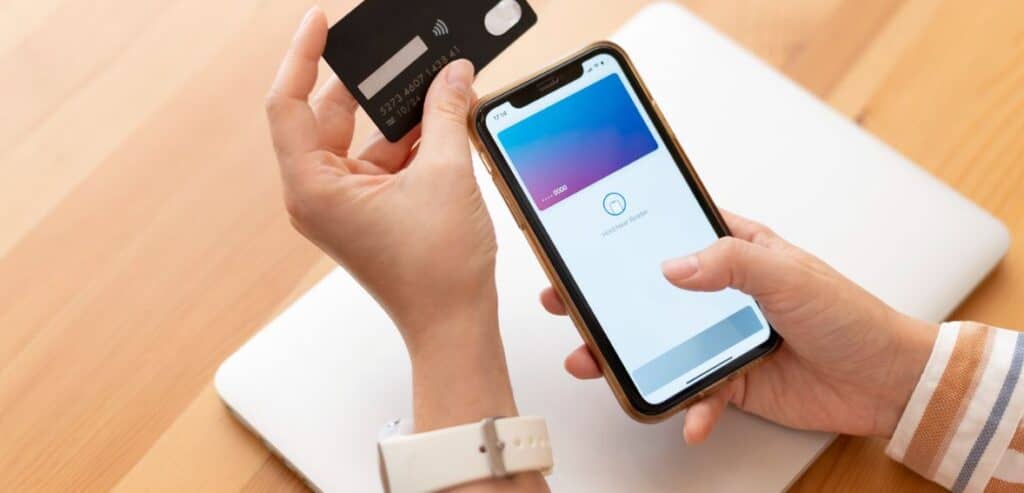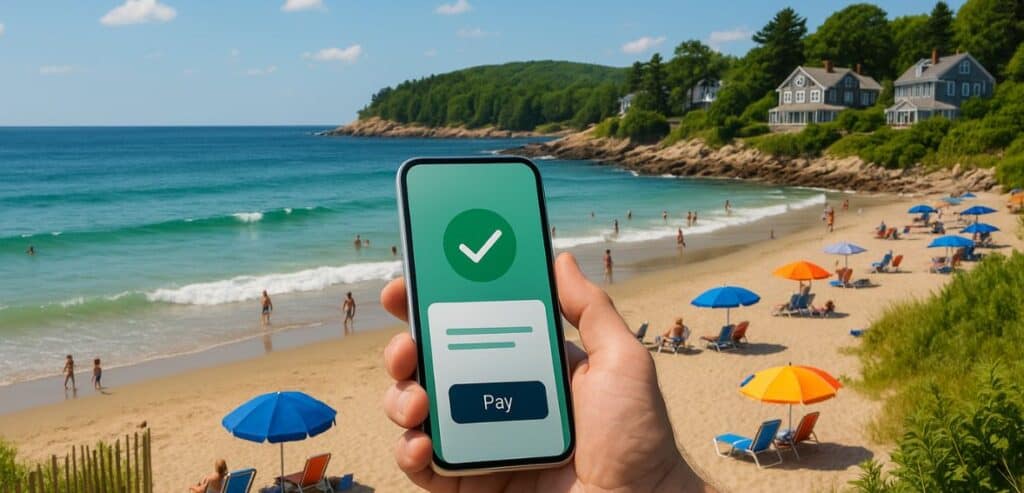
By JudyJEngland June 23, 2025
Known as Vacationland, Maine attracts millions of visitors annually with its stunning coastline, charming towns, and busy summertime destinations like Portland, Bar Harbor, and Kennebunkport. Local businesses are adjusting to new technology in order to meet the expectations of their customers as the state’s tourism sector continues to flourish. Contactless payments have become increasingly popular in recent years, and Apple Pay has been a leader in this space.
Accepting Apple Pay in 2025 is about delivering the smooth, safe, and convenient experiences that both locals and tourists have grown accustomed to, not just staying up to date. Integrating Apple Pay can have a significant impact on Maine retailers looking to increase sales and maintain their competitiveness. Everything you need to know is covered in this guide, including how it operates and how to put it into practice, as well as the advantages, difficulties, and tactical advice unique to Vacationland businesses.
Why Apple Pay Matters More Than Ever in 2025

The use of Apple Pay has increased dramatically in recent years, particularly among younger consumers and tourists who favor digital wallets over cash or physical cards. Maine is a great place for contactless payment systems because of its large number of seasonal tourists and tech-savvy tourists.
By 2025, almost 60% of American consumers will frequently make purchases using Apple Pay. Visitors from major cities like New York, Boston, and Chicago expect the same seamless payment process they get back home when they travel to Maine. Losing out on impulsive purchases could result from not accepting Apple Pay, particularly at independent lodging providers, food trucks, cafes, and local stores where convenience and speed are crucial.
Furthermore, in the post-pandemic era, where consumer behavior is still influenced by hygiene, contactless transactions offer a perceived safety and cleanliness that traditional payments can’t match.
How Apple Pay Works: A Quick Overview
With the help of the mobile wallet service Apple Pay, customers can safely make purchases with their Mac, iPhone, iPad, or Apple Watch. Customers hold their device close to a contactless reader and use Face ID, Touch ID, or a passcode to confirm the payment, eliminating the need to handle cash or swipe a card.
From a technical standpoint, Apple Pay transmits encrypted payment information via Near Field Communication (NFC) technology. What distinguishes it is its emphasis on security and privacy; each transaction is approved by a one-time dynamic security code, and card numbers are not saved on the device or Apple servers. This greatly lessens the burden and risk exposure of merchants who never receive or store sensitive card data in accordance with PCI DSS.
How to Accept Apple Pay in Your Maine Business

In 2025, when the majority of point-of-sale (POS) providers will have integrated support for digital wallets, it’s easier than you might think to get started with Apple Pay. This is a detailed guide designed specifically for Vacationland retailers:
- Examine Your Equipment: Verify that NFC technology is supported by your payment terminal. The majority of contemporary terminals do, but older models might need to be upgraded.
- Cooperate with Your Payment Processor: To verify compatibility and activation procedures, get in touch with your present merchant services provider. Apple Pay is already supported by default by a large number of national companies and processors based in Maine.
- Update Your Software: To avoid integration problems, make sure your POS system is up to date with the most recent version.
- Train Your Staff: To ensure seamless customer service, train staff members on how Apple Pay operates. Assure them to search for the universal contactless symbol or the Apple Pay logo.
- Post Apple Pay Signage: Inform visitors and residents that you take Apple Pay. Menu icons, countertop signs, and window decals all promote use.
- Test the System: Prior to going live, have your employees try a few sample transactions. By doing this, awkward situations during peak hours are avoided.
Where Apple Pay Shines in Vacationland

Apple Pay provides special benefits for a range of Maine-specific business types. Let’s examine some examples:
- Lobster Shacks and Food Trucks: Food trucks and seafood stands are high-profit ventures in the summer. Using Apple Pay speeds up checkout and minimizes the need to handle cash.
- Boutique Inns and B&Bs: Digital wallets streamline the check-in and check-out process and appeal to tech-savvy tourists seeking convenience.
- Outdoor Adventure Guides: Bike shops, kayak rentals, and whale-watching excursions frequently serve travelers who are constantly on the go. In remote locations, Apple Pay enables speedy and contactless transactions.
- Craft Fairs and Artisan Markets: Maine is renowned for its handcrafted goods. When local fairs or farmer’s markets accept Apple Pay, it reduces friction and encourages impulsive purchases.
Benefits Beyond the Transaction
In addition to speed and ease, Apple Pay provides Maine businesses with a number of benefits:
- Security: Tokenized transactions lower the risk of fraud and chargebacks.
- Customer Loyalty: Travelers are more likely to recommend your company or come back the following season if they have a positive checkout experience.
- Operational Efficiency: Spend less time reconciling credit card slips and counting cash.
- Reduced Abandoned Sales: If customers can pay quickly using their phone, they are more likely to finish a purchase.
Challenges and How to Overcome Them
Despite the obvious advantages, there are a few obstacles to be aware of:
- Initial Costs: A small investment may be necessary to upgrade to a terminal that is NFC compatible. Still , a lot of processors provide lease options or subsidies.
- Staff Training: To prevent lags or misunderstandings, make sure all team members are knowledgeable about using Apple Pay.
- Connectivity Issues: Remote or mobile setups, such as food carts or beach stands, may experience issues with internet connectivity. Think about offline transaction capabilities or mobile hotspots.
- Limited Consumer Knowledge: It’s possible that some elderly consumers or foreign visitors are unfamiliar with Apple Pay. Always provide a variety of payment methods.
Integrating Apple Pay with Loyalty Programs and Apps

It shouldn’t be necessary to completely redesign your payment system in order to add Apple Pay. It easily integrates with a large number of the leading payment processors that small businesses currently use. Apple Pay support is frequently integrated into Square, Stripe, Clover, or Toast, or can be obtained with a quick update.
Making sure that every device used in-store or while traveling supports NFC and tokenization is crucial. During every transaction, these technologies enable the secure transmission of encrypted data. To guarantee a seamless and safe implementation, your provider should also be Payment Card Industry (PCI) compliant and provide technical support.
Apple Pay should be integrated into the websites and mobile applications of merchants who have eCommerce components. Adding Apple Pay to your online store improves customer satisfaction and lowers cart abandonment, particularly for mobile customers. This feature is natively supported by the majority of popular platforms, including Shopify, Wix, and WooCommerce. To ensure compatibility, make sure the POS software updates are applied on a regular basis for physical locations.
During integration, your employees are vital. Make sure that everyone is aware of how Apple Pay operates, the advantages it offers to both customers and merchants, and how to resolve common problems. A seamless, assured checkout process fosters repeat business and increases trust. Don’t undervalue the significance of a smooth payment, particularly during the peak travel season when effectiveness is essential.
Marketing Tip: Use Apple Pay as a Value Proposition
Inform your clients when Apple Pay is activated. Display your acceptance of Apple Pay on your website, in point-of-sale signage, and on window decals. Tech-savvy tourists may see social media posts showcasing this feature before they even enter your establishment, particularly during the busiest travel seasons. Make reference to it in email newsletters and other promotional materials to let prospective customers know how simple and adaptable your website is.
Think about adding Apple Pay as a payment option to your Yelp, Google Business Profile, and other local directories. When traveling, tourists frequently look for establishments that take mobile payments. Additionally, use your imagination by collaborating with local lodging establishments or tour companies to advertise that you take Apple Pay, thereby contributing to a flawless vacation experience. Promotions like modest discounts for Apple Pay users can boost uptake and present your company as progressive and accessible to tourists.
Overcoming Common Concerns from Merchants
Because of misunderstandings, some Maine retailers are reluctant to accept Apple Pay. They are concerned about lack of local demand, setup costs, and technical complexity. Since many companies already have compatible systems, the hardware cost is actually frequently very low. Furthermore, demand is already present. Urban tourists anticipate that Apple Pay will be available as standard.
Another concern is uncertainty around transaction fees. That’s why working with a provider that offers transparent pricing is essential to avoid hidden costs and ensure you understand exactly what you’re paying for.
Although security is still an issue, Apple Pay is safer than conventional cards thanks to its use of biometric authentication and tokenization. No personal information is given to the merchant, and there is no actual card to scan. Ask other nearby companies that have implemented Apple Pay about their experiences if you’re still not sure. Peer validation frequently offers the confidence required to proceed with assurance.
Preparing for the Future
Adopting Apple Pay in 2025 will help you future-proof your company in addition to satisfying present customer expectations. Mobile wallets and contactless payment methods are poised to take the lead as more technologies enter the market. Seamless, touch-free options are especially popular with Gen Z and Millennial consumers. By putting Apple Pay into use now, you’re not only meeting demand now but also laying the foundation for even more sophisticated tools down the road.
Accepting Apple Pay not only increases customer satisfaction but also expedites checkout procedures, lowers operational errors, and reduces the need for cash, which simplifies bookkeeping and lowers the risk of theft. You’ll be better equipped to adjust to upcoming innovations like loyalty integrations, dynamic pricing, and real-time transaction reporting when Apple Pay is a part of a larger digital payment strategy.
Take into account that digital payments frequently yield insightful data. These can assist in monitoring customer return rates, average transaction spend, and peak hours. Apple Pay might combine with AI-based solutions that anticipate inventory requirements or automate customer interaction as digital ecosystems develop. Your company can profit from these upcoming improvements with little difficulty if you embrace the technology now.
Conclusion: Welcoming the Digital Traveler
Warmth, hospitality, and values rooted in community have long been attributes of Maine merchants. Adopting Apple Pay in 2025 is an additional step toward providing the kind of contemporary, seamless travel experience that today’s tourists demand. It reflects the future-readiness of your company and is more than just a way to make payments.
Every little thing you do, like making sure your hardware is compatible or using Apple Pay in your marketing, contributes to gaining the trust and loyalty of your customers. Offering contactless, secure, and easy payment methods is a competitive advantage that you can’t afford to overlook, particularly in economies that rely heavily on tourism like Maine’s.
By making the change now, you will not only serve your current customers but also set up your company for future growth prospects. Not only is it wise to accept Apple Pay, but it’s the kind of progressive step that keeps Vacationland open, creative, and available to everyone who enters your establishment.
Leave a Reply